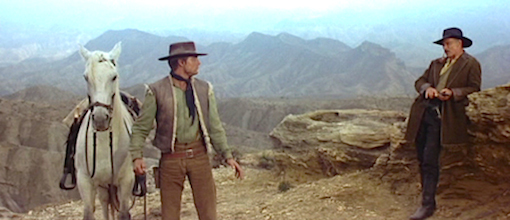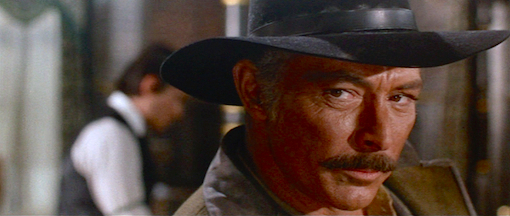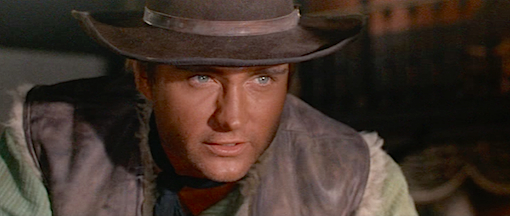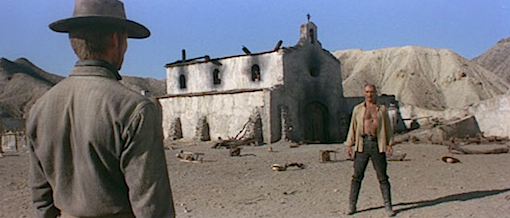HOME | REVIEWS: A-Z | FURTHER READING | NEWS | ABOUT

Death Rides a Horse
1967 / Colour / 115 m. / Italy / Da uomo a uomo
Starring: Lee Van Cleef, John Phillip Law, Luigi Pistilli, Anthony Dawson, Mario Brega, Jose Torres, Franco Balducci, Guglielmo Spoletini, Bruno Corazzari, Archie Savage
Cinematography: Carlo Carlini
Production Designer: Franco Bottari
Film Editor: Eraldo Da Roma
Original Music: Ennio Morricone
Written by: Luciano Vincenzoni
Produced by: Alfonso Sansone and Henryk Chrosicki
Directed by: Giulio Petroni
Reviewed by Lee Broughton
Synopsis:
Four vicious bandits callously abuse and massacre a family while executing a $200,000 robbery. A small boy survives the attack and grows into a young man, Bill (John Phillip Law), who is intent on seeking revenge. He finally gets the lead he’s been waiting for when a recently released convict, Ryan (Lee Van Cleef), passes through the locality. It soon becomes clear that the two sharp-shooting gunmen are hunting the same villains but complications arise when Ryan tells Bill that he doesn’t need his help.
Critique:
Established Spaghetti Western fans already know that Death Rides a Horse is one of the genre’s most highly regarded films. A big-budget genre entry that secured a worldwide cinema release via the American distribution company United Artists, there was a time when this show’s public profile was almost as high as that of Sergio Leone’s Dollars films with Clint Eastwood. Death Rides a Horse’s star, Lee Van Cleef, had of course featured in two of those very films, For a Few Dollars More (1965) and The Good, the Bad and the Ugly (1966).
Iconic stills of Van Cleef taken from Death Rides a Horse’s final showdown sequence regularly adorned the sleeves of the Italian Western soundtrack compilation albums that were issued during the 1970s and the show’s highly idiosyncratic soundtrack score — which featured heavily on said albums — went on to become a firm fan favourite. Written by genre stalwart Ennio Morricone, the score remains one of the composer’s very best efforts and director Giulio Petroni puts every one of its excellent cues to really good use here.
Quentin Tarantino evidently liked the way that Petroni and Morricone worked together too. Part of Morricone’s Death Rides a Horse score appears amongst the borrowed music selections that Tarantino employed in Kill Bill (2003) and that film also features a number of narrative and visual elements that are designed to pay further homage to Petroni’s remarkable Western.

Reworking elements of his own For a Few Dollars More script (the flashback-fuelled vengeance narrative and the uneasy alliance that is eventually forged between two normally solitary gunmen) — and seemingly taking inspiration from Tonino Valerii’s Day of Anger (1967) too (the hard-hearted older gunman teaching the cocky young gunslinger a series of harsh lessons in survival) — resulted in the film’s writer Luciano Vincenzoni blessing Death Rides a Horse with a really engaging, exciting and well-paced storyline.
Death Rides a Horse is also a well-acted film. Ryan is one of Lee Van Cleef’s best-realized genre characters and he’s brought to life via a supremely confident performance. It’s incredible to think that Van Cleef had, to all extents and purposes, retired from acting in American movies prior to being offered a co-starring role in Leone’s second Italian Western, For a Few Dollars More, in 1965.

Long, lean and suitably impassive until he gets angry, John Phillip Law’s sheepskin vest and shrunk-fit corduroy trousers-clad Bill is as cool and as iconic looking as the two other major characters — Pygar in Roger Vadim’s Barbarella (1968) and Diabolik in Mario Bava’s Danger: Diabolik (1968) — that Italian popular filmmakers hired him to play during the late 1960s.
There’s a great chemistry present between Van Cleef and Law here and it’s a real shame that they weren’t paired together in any subsequent genre entries. But while the duo make for a formidable team, the bad guys that they’re facing here are no slouches either. Sergio Leone regulars Luigi Pistilli and Mario Brega — along with genre stalwarts like Jose Torres and Bruno Corazzari — provide expertly executed turns that ensure that the film is populated with an interesting range of particularly vindictive bad guys who are more than capable of giving our anti-heroes a run for their money.
A number of the bad guys that Bill and Ryan are intent on tracking down have used the proceeds of their heinous crime to embark on new lives as respected town elders and important politicians — a popular theme in Spaghetti Westerns that seemingly passes allegorical comment on the Italian public’s ongoing concerns about organized crime and its links to political corruption — and this makes the duo’s quest for revenge all the more difficult. The British actor Anthony Dawson provides a nuanced performance as one of these former villains, the shrewd and hawkish saloon-owner-cum-master gambler Burt Cavanaugh.

It has to be said that the nature of a “shock” revelation about one of the film’s main characters that appears towards the end of the show is easily predicted. But this somewhat obvious narrative contrivance still manages to act as a device that successfully sets the film up for a tense and emotionally involving finale.
Death Rides a Horse compares well to Leone’s Dollars films at both a technical and an aesthetic level. Petroni and cinematographer Carlo Carlini put a really good-looking movie together here and the film possesses a quite epic feel. The film’s art direction and costume designs are also top class. But while Petroni pays homage to the generic Spaghetti Western conventions that Leone had established a few years earlier — there are some really great extreme close-ups present here — he isn’t a Leone copyist by any means. For example, the show’s final duel is Leone-like in terms of its protracted nature but its actual staging and payoff are really quite original and distinctive.

Petroni is also able to bring his own sense of exaggerated formalism to the film at times. Some of the show’s action scenes are staged in a playful and almost comic strip-like manner which adds a noticeable sense of speed and dynamism to the proceedings that is particularly striking.
The sequences where Bill suddenly recognizes one of the personal items (ear ring, spur, tattoo, etc) that are his only means of identifying the men that he is searching for all work really well too: a rapid mix of snap zooms, intense facial expressions, tinted flashback overlays and thunderously ominous music cues signal that violent mayhem of some description is about to erupt. The staging and ambience of these sequences where Bill comes face to face with those who wronged him all those years ago bring to mind the heavily stylized sequences that precede Liam Neeson’s adrenalin-boosted flip-outs in Sam Raimi’s Darkman (1990).
Ultimately, the obvious handiwork of Ennio Morricone and Luciano Vincenzoni and the iconic presence of Lee Van Cleef, Luigi Pistilli and Mario Brega effectively combine with Giulio Petroni’s stylish and assured direction to produce a film with content that looks and feels as if it is set within the same diegetic universe as Sergio Leone’s Dollars films. And no higher compliment than that can be paid to a non-Leone Italo-Western. As such, Death Rides a Horse would work as an ideal introduction to the wider delights of the Spaghetti Western genre for those curious Sergio Leone or Clint Eastwood fans who have yet to sample a non-Leone/Eastwood genre entry.
Psychotronic Cinemas rating: Excellent –
© Copyright 2011, 2017 Lee Broughton.
HOME | REVIEWS: A-Z | FURTHER READING | NEWS | ABOUT
You must be logged in to post a comment.